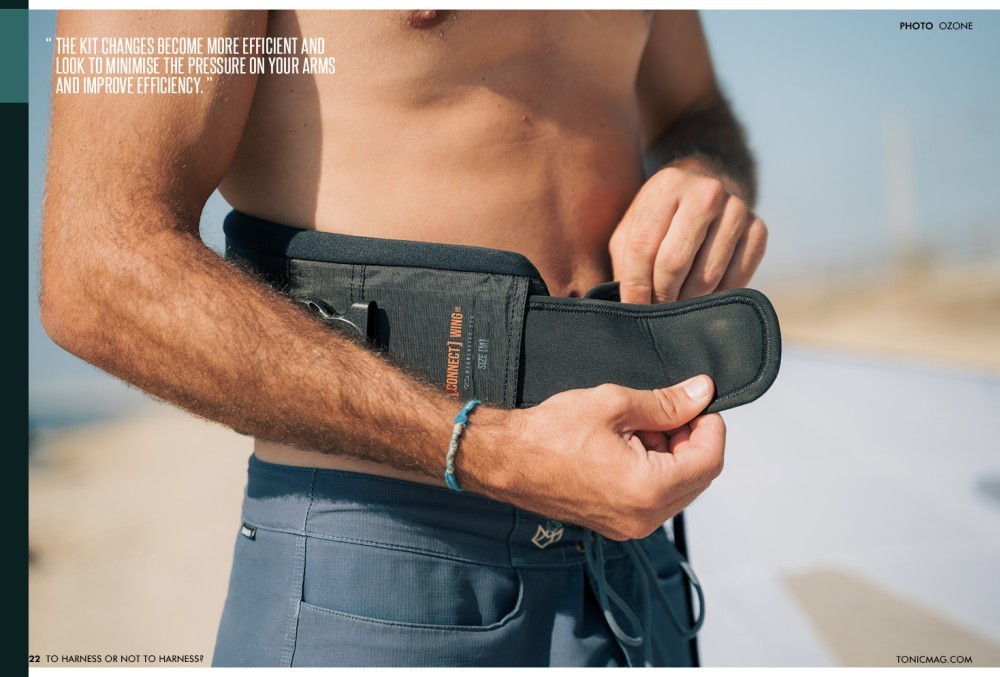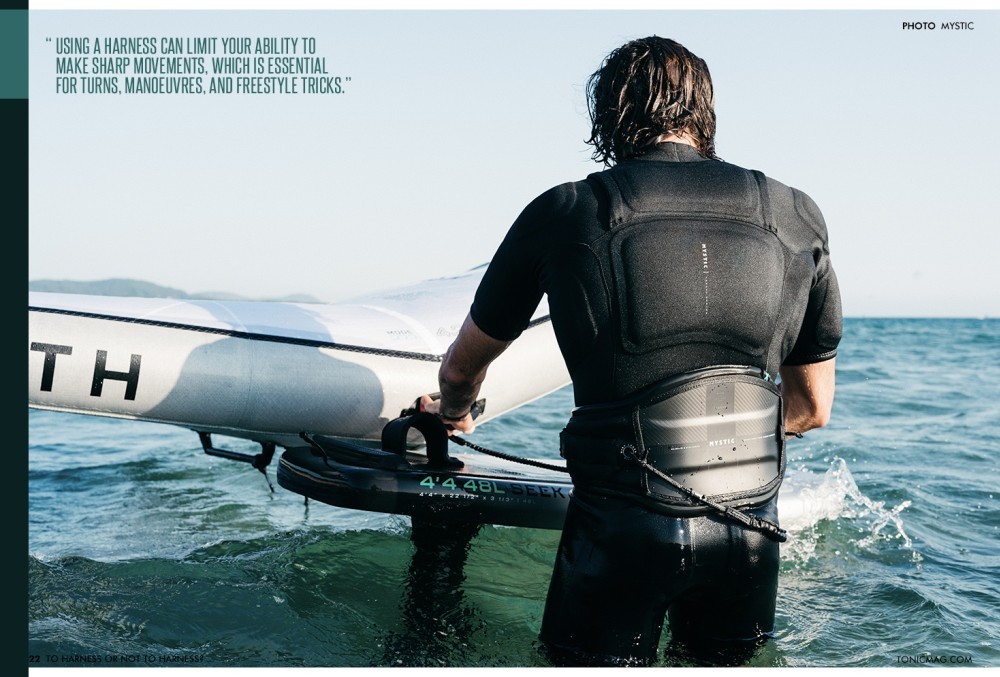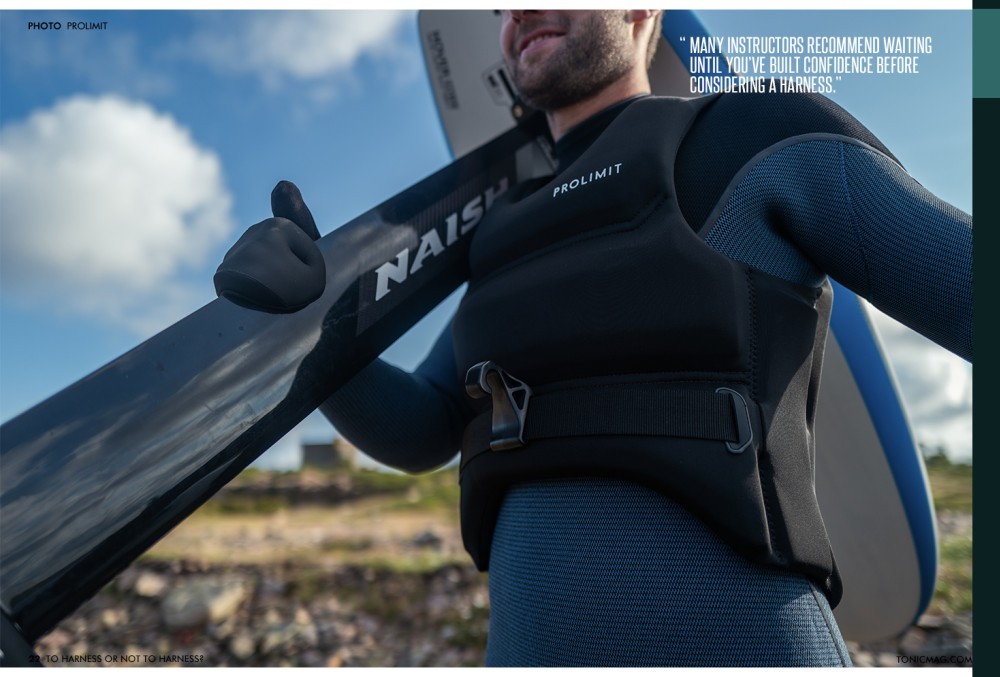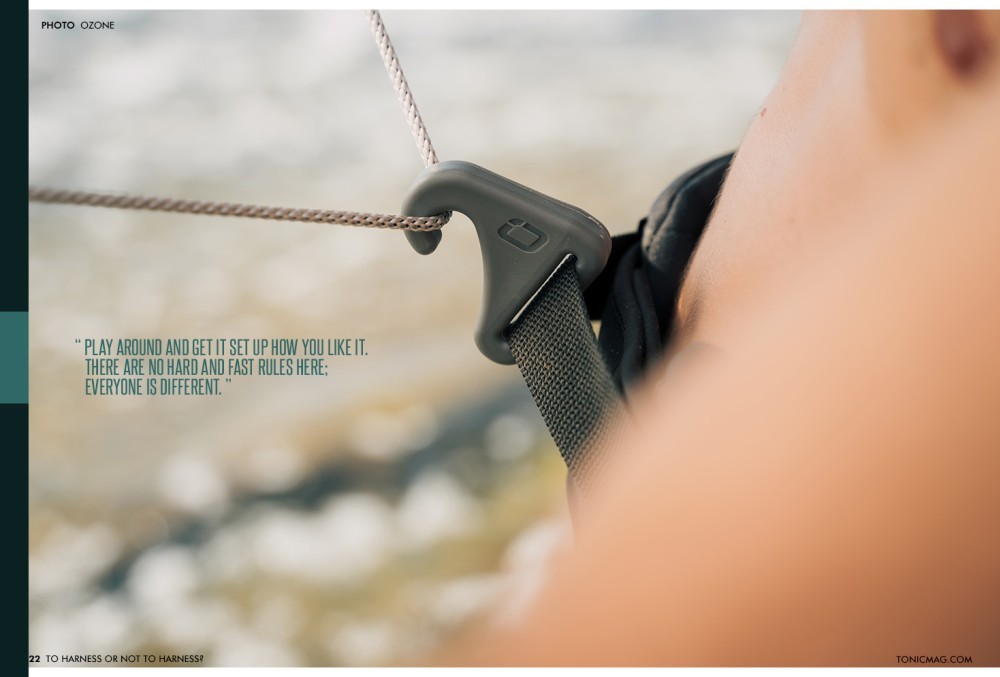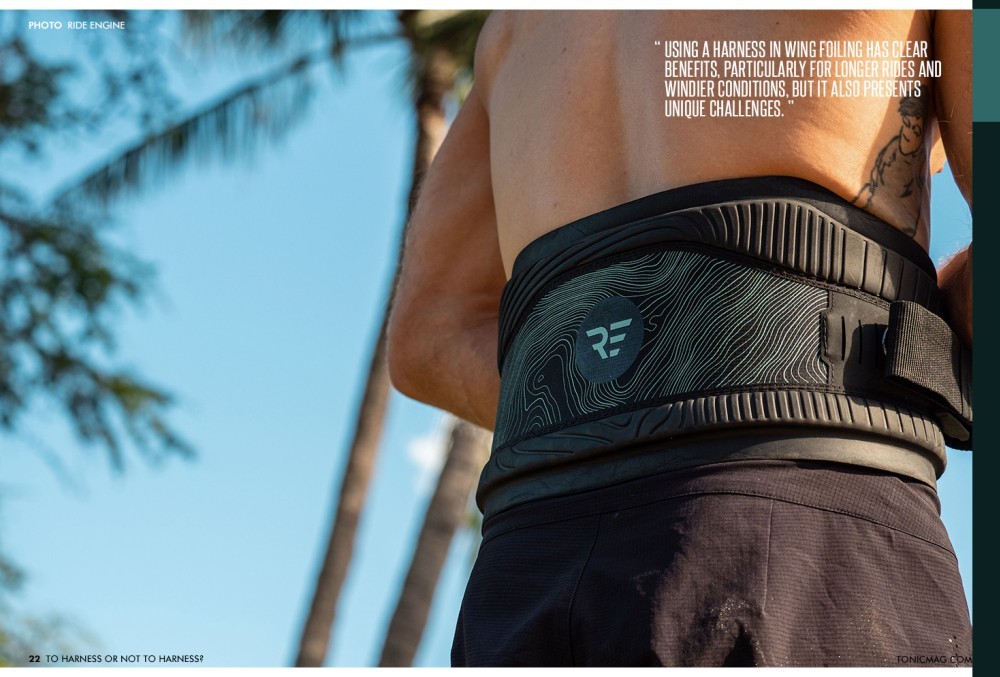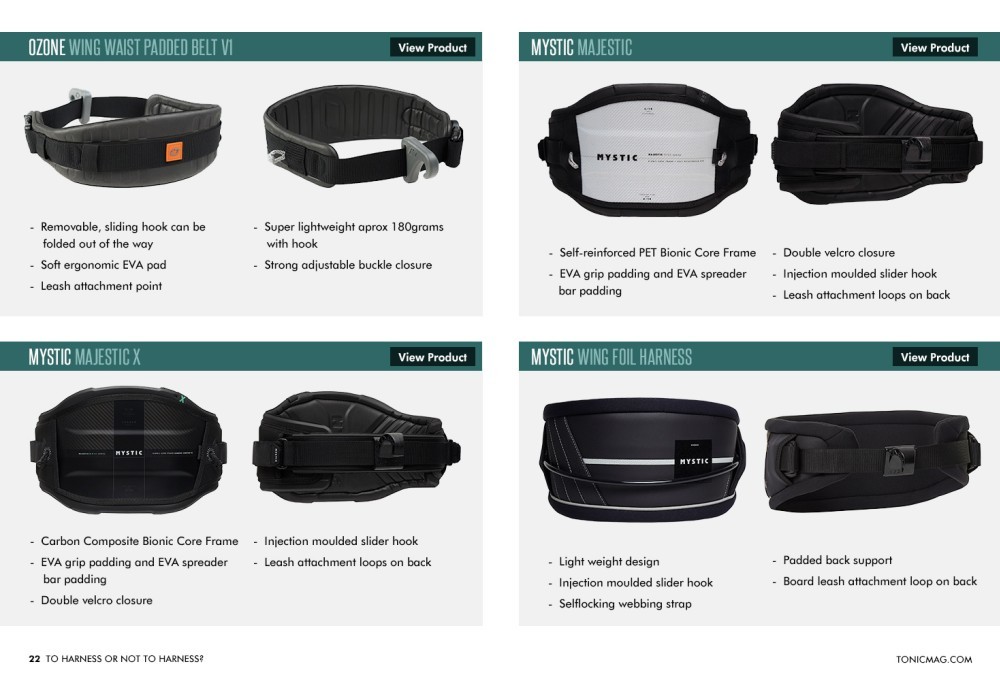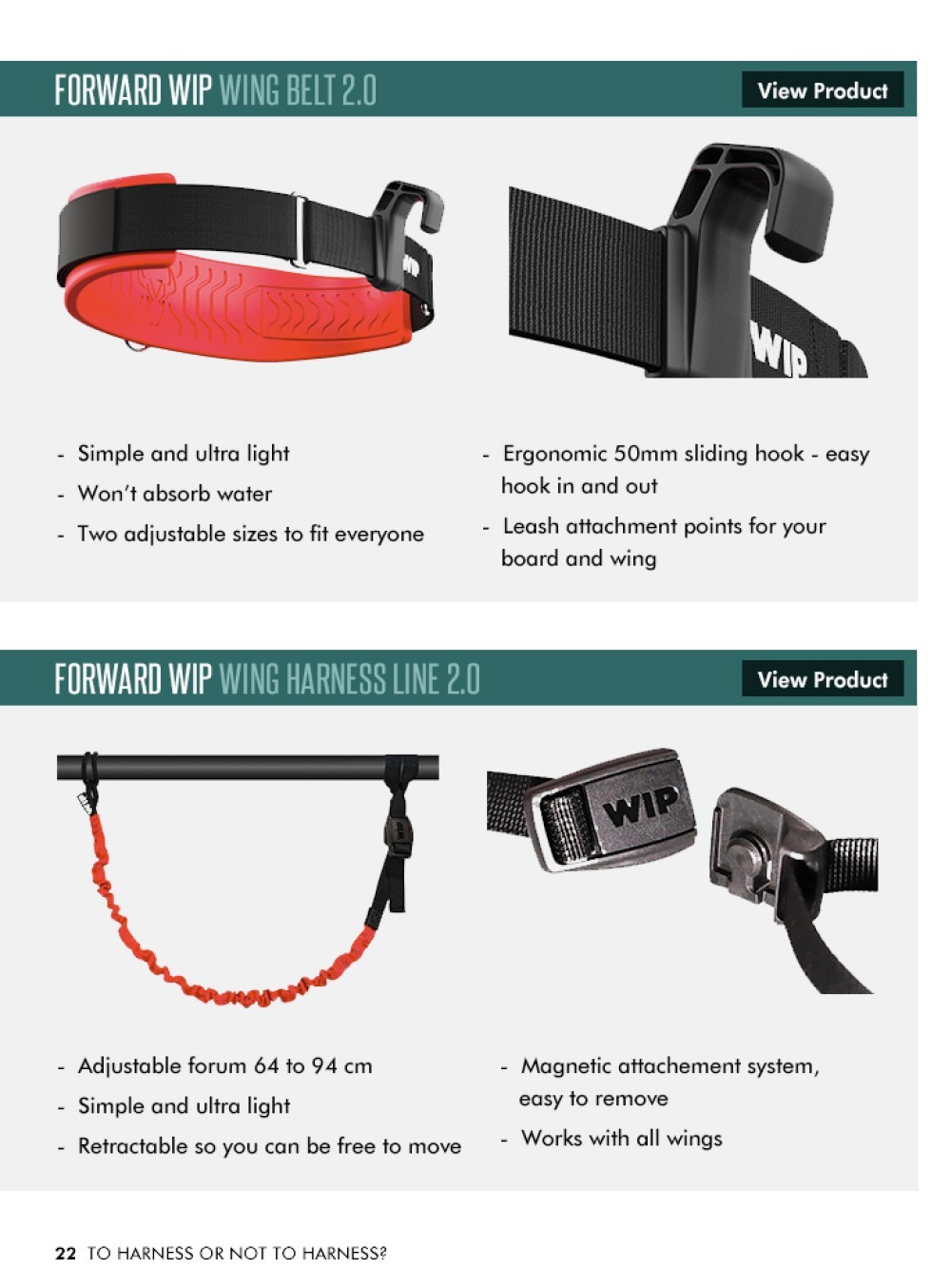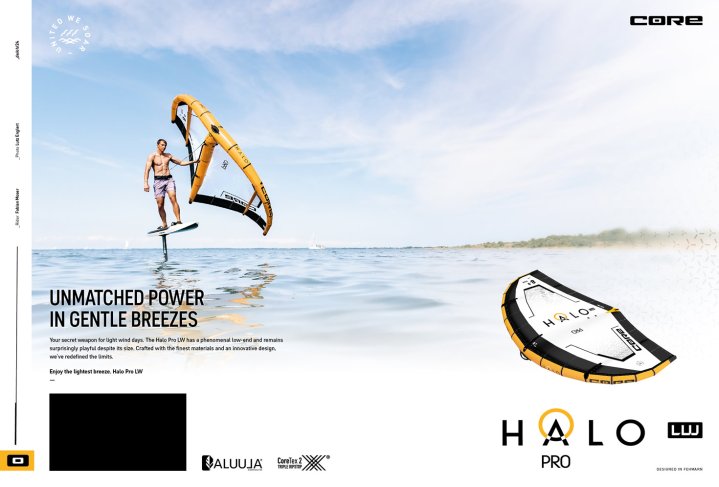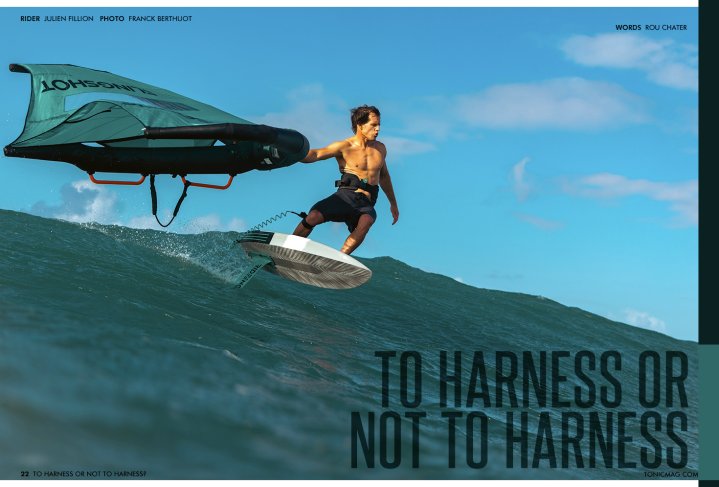
To Harness Or Not To Harness?
Issue 22 / Thu 21st Nov, 2024
Rou Chater looks at the pros and cons of the humble harness, an accessory adopted by windsurfers in the late 1970s and used ubiquitously across pretty much every wind-powered sport ever since—until winging came along, that is. When you consider the benefits of a harness, it’s often hard to comprehend why they aren’t more widely used…
It feels a bit strange writing this article, as I expect a 50/50 split of people thinking, “What the hell are you talking about?” depending on what side of the fence you sit on. Reading this, you’ll either be a harness lover or a hater; there doesn’t seem to be much of a happy in between, although perhaps that is changing as downwinding continues to stamp its authority on the sport of foiling.
When I first learned to wing foil in 2019 at the Naish launch of the Wingsurfer, and arguably the launch of the sport, I found it incredibly physically demanding. As I sit on the very wrong side of 40, I figured this was a good thing, a sure-fire way to peak physical fitness and that six-pack that’s been eluding me for the last twenty years or so. Wing foiling was physically demanding, not just the climbing on and off the board endlessly, but your upper body and shoulders got a beasting an army PT would be proud of.
Like any sport, with time, you improve, fall in less, spend more time on the foil, and the wing’s resistance diminishes. The kit changes become more efficient and look to minimise the pressure on your arms and improve efficiency. It didn’t take long before a one-hour session that would leave me lying wrecked on the breach; gasping for breath became a breeze, and then a two-hour session seemed easy.
I did all of this without the aid of a harness and just used my body to conduct the power from the wing to the foil. In time, wing foiling became effortless, especially if you had the right size wing for the conditions. My hopes of a six-pack faded fast. It is still, pound for pound, one of the best workouts I do, and by workouts, I’m talking kitesurfing and surfing. It’s a great workout across your whole body, as many of you will agree.
Harnesses have been around in wing foiling since the beginning, and in the UK, spot-led as to whether they are used or not. I’ve seen the same thing overseas; some places seem to love them, and others barely feature. Here in Pembrokeshire, there is a really low uptake. We mainly ride waves, and I think the feeling of freedom gets people here. However, having a harness can extend your session indefinitely, meaning more weaves, more fun, and a minimal payoff from strapping one on at the beginning of your session.
These days, I mix and match; if I ride around the wave spot and have some fun in a smaller area, I’ll not bother with the harness; I’m never slogging upwind long enough to feel I need it. Downwinders are the same; I don’t feel it is necessary. However, we have been doing many more ‘Upwind/Downwind” sessions lately, and a harness is a game changer. I can hook in and smash the upwind out while saving all my energy for the downwind mission. It’s been enlightening.
Other instances of use include racing, speed, endurance sessions, and just wanting to reduce fatigue, but let’s dive into the pros and cons and look at the arguments from each side…
Advantages of Using a Harness in Wing Foiling
- Reduced Arm Fatigue: One of the biggest challenges in wing foiling is maintaining control over the wing for extended periods, which can be tiring on the arms and shoulders. A harness lets you rest your arms by transferring some of the wing’s pull to your torso. This can be a game-changer on long sessions, as it helps you stay out on the water longer.
- Better Power Control in High Winds: Holding the wing without a harness can be tough in higher wind conditions. With a harness, you can hook in and use your body weight to counterbalance the force, giving you more control and enabling you to handle stronger gusts with less physical strain.
- Improved Stamina for Long Distances: A harness can be invaluable if you plan to cover longer distances or go on exploratory sessions. It reduces the need to grip the wing continuously, helping you conserve energy. This benefits wing foilers looking to do endurance-focused rides or even race events.
- More Stability in Choppy Conditions: The added point of contact with the harness can provide increased stability when dealing with choppy waters or large waves. This added leverage can help maintain a smoother ride, as you can engage your core and legs more effectively to stabilise the board and wing.
- Cold Weather: In the depths of winter in the UK, it gets pretty chilly, and while palmless mitts are a revelation for winging, a harness can also help you get the blood flowing back into your hands. You can let go of the wing with one hand much easier and give it the magic blow or shake, or even just hang it by your side and allow gravity to help the blood back into your fingers.
- Waving at Your Mates: We’ve all been there. You see your mate kiteboarding, and you can’t wave at them, especially if you aren’t skilled and riding handles and not a boom. It also means you can blow your nose more easily, which is excellent if you have just had drilling and filled your sinuses with seawater.
Disadvantages of Using a Harness in Wing Foiling
- Reduced Mobility and Flexibility: Using a harness can limit your ability to make sharp movements, which is essential for turns, manoeuvres, and freestyle tricks. Since wing foiling often involves quick shifts in body position, being hooked in can hinder your freedom to manoeuvre fluidly. For those who enjoy a more free-flowing style, this can be restrictive.
- Increased Risk of Falling with the Wing: Hooking into the wing introduces the risk of getting tangled or “dragged down” if you lose control. Being attached can cause an unwanted pull or create difficult situations where you cannot quickly release from the wing.
- More Gear to Manage: The beauty of wing foiling lies in its simplicity. Adding a harness adds more equipment, which means more things to manage and adjust. For those who prefer a minimalist approach, the harness might feel cumbersome and unnecessary, particularly if they’re only out for short sessions or light winds.
- Potential Learning Curve Issues: For beginners, managing a harness while focusing on wing control, balance, and foiling can be challenging. Adjusting the harness lines and learning when to hook in and out require extra skills, which might complicate the learning process. Many instructors recommend waiting until you’ve built confidence before considering a harness.
Who Should Consider Using a Harness?
A harness can benefit intermediate to advanced riders prioritising longer sessions, distance, or efficiency in high winds. If you’re experienced with foiling and comfortable controlling the wing, a harness may offer the support needed to take on more challenging conditions without burning out your arms. If you’ve never tried one, ask yourself why not. If you feel like your sessions might benefit, give it a go; you might be surprised; if you don’t like it, no one is forcing you to carry on either…
Tips for Using a Harness Safely in Wing Foiling
Practice Hooking In and Out Quickly: Practice releasing from the harness under different conditions to build muscle memory and confidence. Do this on the beach at first. This is also really important when setting up the harness lineup. Getting it dialled in on the beach is much easier than on the water.
Choose the Right Harness and Lines: Lightweight waist harnesses with easily adjustable lines are popular in wing foiling. Some great impact vests have built-in harness options, too, meaning you can kill two birds with one stone.
Adjust for Comfort and Control: Be prepared to adjust your set-up and tune it to your needs. No one is the same, and some riders like a shorter harness line while others prefer something longer. Play around and get it set up how you like it. There are no hard and fast rules here; everyone is different.
Don’t Just Take Our Word For It
We asked a couple of people in the know how they felt about a harness…
“Harnesses can make a real difference to your comfort, body position and sustained performance over a long session, particularly in stronger conditions and when you want to get upwind fast and efficiently. That’s why we have two harness options: the Connect Wing Wing V2, which offers higher levels of support, and the Wing Waist Padded Belt, which is super light and offers more support than a standard belt. These designs are about comfort and free body movement when you’re not hooked in. Minimum restrictions with important support benefits.”- Torrin Bright - Ozone Product Manager
“I fully understand the purist view of not wanting to use a harness. It can be viewed as a non-essential piece of gear for wing foiling. And I will even say for myself, I like the purity of not having to use one and being free. But! The harness has found its way into my gear selection in certain circumstances. If I am just going out for a lunch rip, I don’t use it as I will be on the water for 30 to 45 minutes tops and just chasing short laps of swell. But, if it is the weekend and I am going for a mega up-winder to downwinder, a harness is 100% a necessity for these multi-hour missions. Also, depending on the set-up, a harness can make or break a good session in the surf. For example, in my second home of Peru, having a harness to rip back up the point is nice to let the arms take a breather and allow me to point upwind just that bit more relaxed to make it in one reach.”- Gary Siskar - Ride Engine Product Line Manager/Director of Marketing.
Final Thoughts
Using a harness in wing foiling has clear benefits, particularly for longer rides and windier conditions, but it also presents unique challenges. It’s an excellent option for those looking to conserve energy or gain extra control in high winds, while freestyle riders or beginners may find it restrictive. The choice ultimately comes down to your riding style, goals, and comfort level.
As with all things in water sports, experimentation and finding what works best for you is critical.
We’ve put together some of the best options on the market right now from some of the biggest brands so you can see what might suit you and your style…
01 Prolimit
Drift
- Pre curved 3D shape
- Maximum freedom of movement
- Camlock closure system
- Sliding hook system
- Double D ring leash attachment points
- https://www.prolimit.com/collections/wingsurf-harnasses/products/drift-copy-1
Shield FR Vest
- Armadillo Armor high density foam for maximum protection
- Soft shell back plate for maximum support
- YKK Side zipper for easy entry
- YKK zippered front pocket for storage
- Sliding hook
02 Ride Engine
Vinaka Pro Waist
- Thermo formed moulded design
- Rash free non water absorbing design
- Hook and loop closure system
- The Nug sliding hook
- Dual D ring leash attachment points
- https://rideengine.com/collections/wing-foil-harnesses/products/vinaka-pro-v1-harness
Free Float Chest
- 4 Point Chest Cradle minimalist perfect for downwinders
- Integrated hydration bladder
- Hook and loop closure system
- The Nug removeable hook
- EVA padded back for comfort
- https://rideengine.com/collections/wing-foil-harnesses/products/free-float-wingsurf-chest-harness
03 Ozone
Wing Waist Padded Belt V1
- Removable, sliding hook can be folded out of the way
- Soft ergonomic EVA pad
- Leash attachment point
- Super lightweight aprox 180grams with hook
- Strong adjustable buckle closure
- https://ozone-uk.com/product/ozone-wing-waist-padded-belt-v1/
04 Mystic
Majestic X
- Carbon Composite Bionic Core Frame
- EVA grip padding and EVA spreader bar padding
- Double velcro closure
- Injection moulded slider hook
- Leash attachment loops on back
- https://www.mysticboarding.com/collections/wing-harness
Majestic
- Self-reinforced PET Bionic Core Frame
- EVA grip padding and EVA spreader bar padding
- Double velcro closure
- Injection moulded slider hook
- Leash attachment loops on back
- https://www.mysticboarding.com/products/majestic-wing-harness?variant=47138839134552
Wing Foil Harness
- Light weight design
- Injection moulded slider hook
- Selflocking webbing strap
- Padded back support
- Board leash attachment loop on back
https://www.mysticboarding.com/products/wingman-wing-foil-harness?variant=41174736994483
05 Forward Wip
Wing Belt 2.0
- Simple and ultra light
- Won’t absorb water
- Two adjustable sizes to fit everyone
Ergonomic 50mm sliding hook - easy hook in and out - Leash attachment points for your board and wing
- https://www.forward-wip.com/produit/wing-belt-2-0/
Wing Harness Line 2.0
- Adjustable forum 64 to 94 cm
- Simple and ultra light
- Retractable so you can be free to move
- Magnetic attachement system, easy to remove
- Works with all wings
- https://www.forward-wip.com/produit/wing-harness-line-2-0/
06 Dakine
Solo
- Hanger Wing Sliding Hook
- Posi-Lock Buckle
- Soft neoprene construction
- Lightweight and packable
- Low profile fit
Fly
- Hanger Wing Sliding Hook
- Spreader Pad
- Posi-Lock Buckle
- Curv Composite Flex Shell
- Lightweight
By Rou Chater
Rou Chater has been kitesurfing for over twenty years, paddleboarding for the last six years, and was there testing the first wingsurfer from Naish in Tarifa when it arrived on the continent. He is passionate about riding waves and exploring new places. As the publishing editor, he oversees everything at Tonic but also our sister magazines IKSURFMAG and IMB. He's been on the water since he was born and has never looked back, in the winter you'll find him chasing swells in the Caribbean and during the summer he can be found all over Europe at various SUP, Kitesurf and Mountain Bike events getting features for the magazines.




